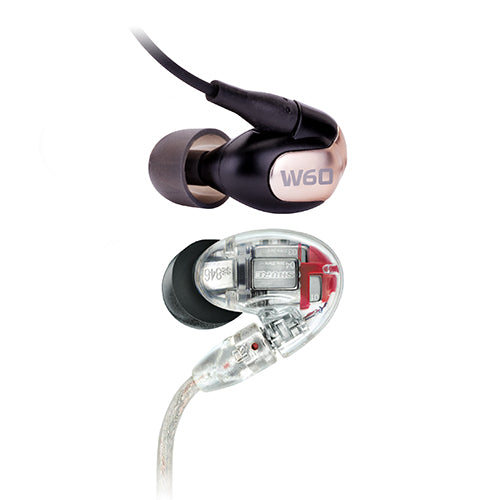Shure SE846 vs Westone W60 Comparison Review
by Adorn Themes Collaborator
(Updated )
Bookmark this article
Copy to clipboard
Email to a Friend

When it comes to top of the line earphones, what models do you consider? The landscape is populated with all sorts of options, from “State of the Art” models made by manufacturers you’ve never even heard of, to custom-molded designs that demand scanning your ear canals with a fine-toothed comb. But when it comes to universal-fitting earphones, we see two particular models coming up again and again – the Shure SE846 and the Westone W60. Just how different are these best-in-class contenders? And which one is right for you?
Shure SE846 vs Westone W60 Comparison
The Shure SE846 comes with a hardshell case not unlike those pencil boxes we used to carry around in elementary school. It’s clear, with two big plastic clasps. Inside of this, you’ll find the earphones, a microfiber cleaning cloth, and a smaller, more travel-friendly case. You’ll also find a second cable, as well as a wealth of eartips, an airline adapter, a 1/4” stereo adapter, and a frequency response customization kit. Gadzooks!
The earphone itself may be a bit large, and while I’ve heard some grumblings on the internet about people having trouble with the fit, I found them to be very comfortable. Granted, I have some large ears (picture a taxicab driving down the street with the doors open), but I doubt they wouldn’t suit even the most medium-sized ears.
With a frequency range of 15-20000 hertz, and a nominal impedance of 9 ohms, this headphone is bound to give you great detail on any low-output device – your smartphone, your portable player, or whatever else you want to use it with.
But how does it really sound? The SE846 is neutral and flat, while perhaps slightly bright. Bass seems a bit underplayed, while mids and highs leap out at you, giving one the impression of massive amounts of detail but occasionally-piercing highs.
The Westone W60 also comes with a heavy-duty case, an opaque, bright-orange specimen with thick clasps and rubber gasket for waterproofing. Inside the Westone case, you’ll discover the earphones, two 4.3 ft (1.3 m) cables – one with a 3-button remote and mic for iOS devices. There’s also a wealth of tips, as well as exchangeable faceplates for the earphones, and a wax removal tool.
While the W60 might have a lower profile, it may not be necessarily more comfortable. I imagine for those with smaller ears, the W60 would be more comfortable than the SE846, and the earphones are definitely a little more inconspicuous when you’re wearing them. They might also feel just a little lighter, thanks to a braided cable (versus the thicker, slightly heavier Shure alternative).
Frequency range on the Westone W60 goes from 20-20000 hertz, and the nominal impedance is 25 ohms. Like the SE846, it’s going to be just fine with any low-power or mobile device, but it may not be as loud at the same volume (due to that higher impedance, of course).
When it comes to the sound of the W60, most listeners will easily recognize a wealth of detail, and a slightly more articulate and contrasting sound. Bass and seems a little more present, while the high end of the frequency range remains rather unchanged. Mid detail is there but not pushed to the fore, giving this earphone a slightly dynamic profile.
So what’s the verdict? While those looking for a flat signature will undoubtedly enjoy the Shure SE846, the contrast and articulation on the Westone W60 may woo those seeking a sharper sound. For classical and some instrumental music, I’d probably recommend the SE846. But for anything with a beat – like rock, hip hop, pop, or any such genre – I would lean more towards the W60.
Get the Latest Headphone News and Reviews in Your Inbox
Subscribe to our newsletter and get 10% off your first purchase!*
*some restrictions may apply


 FREE
FREE 


